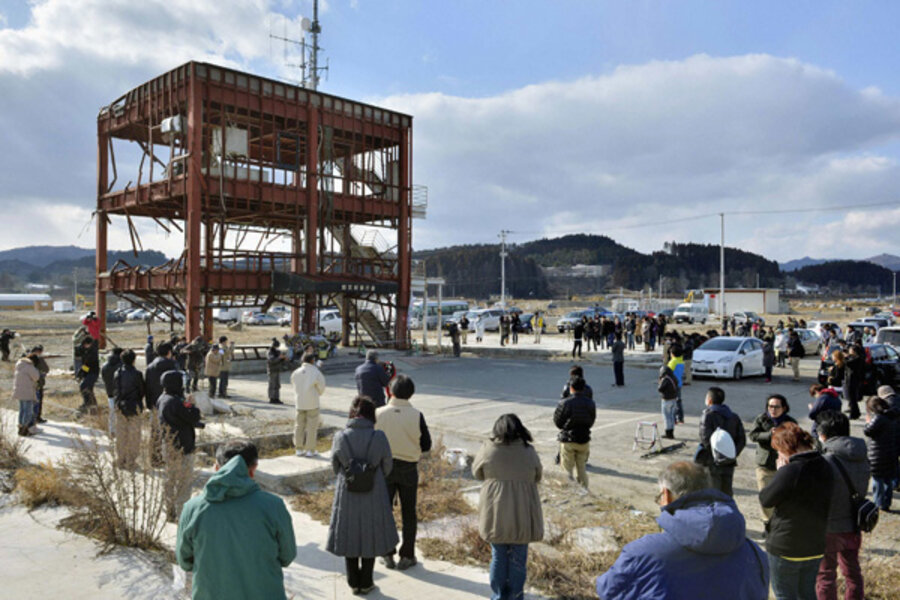Two years after tsunami, Japan's small business owners stuck in limbo
Loading...
| Ishinomaki, Japan
Business is booming at the Aeon shopping mall on the outskirts of Ishinomaki city, on the northeast coast of Japan.
Two years ago a devastating tsunami and earthquake claimed nearly 4,000 lives and damaged 60 percent of the houses in this coastal fishing and factory town. Spared heavy damage because of its inland location, the popular chain supermarket and department store became a temporary home for 2,500 desperate townspeople in the weeks following the tsunami.
Today, sales at the store have bounced back higher than they were before the disaster. The same is true at shopping malls and convenience stores on the outskirts of towns throughout Japan’s tsunami-hit northeastern region, government statistics – and a drive up the coast – show.
But the story is much more complicated for small retail businesses in these communities. Some shopkeepers have been able to reopen and thrive on an influx of tourists, recovery workers, and volunteers. A scattering of innovative new companies has sprouted. But for many local businessmen and women, problems including limited government assistance and lagging reconstruction work are holding back recovery.
Millions of tons of rubble have been cleared and countless buildings demolished along the coast. But the immense task of restoring infrastructure still lies ahead in many areas, and towns like Ishinomaki have yet to finalize detailed recovery plans. In the hardest-hit districts, the landscape remains nearly as desolate as it was a month after the disaster.
The people who once ran businesses in these areas, meanwhile, are stuck in limbo.
Ishinomaki grocer Tadamasa Kimura is one of them.
His shop and home in the town’s port district were washed away by an enormous wall of water that also flattened his entire neighborhood. Last year he reopened in a temporary shopping arcade downtown, where the majority of buildings remained standing.
The shop is tiny but packed with fresh, attractively arranged fruits and vegetables. Mr. Kimura says there are few locals left to buy them: Most have moved to temporary houses on the outskirts of town. Sales are down more than 50 percent, and the customers who do come are usually out-of-towners on bus tours. Yet Kimura says he cannot think about starting over in earnest until infrastructure, jobs, and residents return to his old neighborhood, where he still owns land.
How many shops have reopened?
Manabu Endo, an Ishinomaki native who promotes local businesses through his nonprofit Do Tank, estimates that about half of the shops downtown have reopened. He worries about what will happen if their customers don’t return. The town has lost 11,000 residents since the disaster, half of them under 40.
“If the city center disappears this will stop being Ishinomaki. That matters for tourism too. Who’s going to come here to take a tour of Aeon?” says Mr. Endo, referring to the bustling mall on the outskirts of town.
Ishinomaki shoppers began drifting away from downtown shopping districts in favor of big box stores long before the tsunami hit, Endo says. The pattern is common throughout Japan. In some rural areas falling population was also hitting local businesses hard.
The disaster accentuated these trends.
“If a company has a certain amount of financial muscle and operates in multiple locations outside the disaster area, it can survive. Small local companies are more likely to go under,” explains Satoru Masuda, director of the Disaster Recovery Research Center at Tohoku University’s economics faculty.
The debate about government support
Historically, Japan’s government engineered policies to support mid-sized and small businesses, he says. That kind of support has declined recently.
“The disaster hit within that context. There’s a debate going on right now over how much the government should support small businesses,” he says.
Laws prevent recovery money from flowing directly to individual companies. Since the damage was so severe and extensive, however, the government has created a system through which businesses can receive subsidies if they apply for help in groups.
In the fishing port of Kesennuma, 35 miles north of Ishinomaki, Chamber of Commerce Director Ryoichi Kumagai says that, so far, about 700 out of 3,314 damaged businesses have received money through the program. The funds will help them rebuild, but they won’t secure long-term success.
“Houses are going to be rebuilt on higher land away from downtown. It will be hard to move the shopping arcades to those areas too, so we’ll need some way to draw customers back downtown. The city’s reconstruction plan doesn’t go into detail about how to get the shopping areas back on their feet,” he says.
One company in Ishinomaki is working on a strategy to do just that. Machizukuri Manbow – the same company that runs a famous manga museum in town – is spearheading plans for a walkable city center dotted with tourist attractions and shopping complexes. Locally-owned stores will occupy the first floor of these complexes and shopkeepers will live upstairs, high above any future floods. The company is also lobbying the city to build a produce market and event space on top of a tall river embankment planned nearby. The government’s group subsidies will help finance the projects.
But grocer Kimura says he wants nothing to do with subsidies that force businesses into alliances that may turn messy later. He simply wants to reopen his old store in his old neighborhood.
“For someone like me, there is no support. We’re forced to rebuild with our own resources,” he says.
No matter how hard that may be, he says, he is determined to do so.







